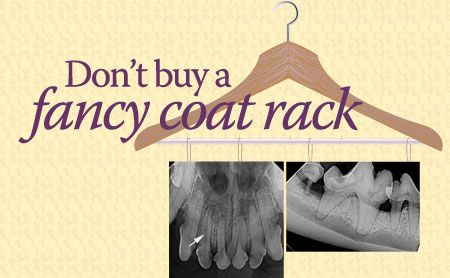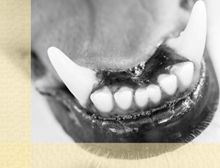Dental radiography overview (so you don't buy a fancy coat rack)
Figure out what you really need and will really use. (And then make sure you do it by putting the right systems in place to support your teams plan.) Heres an overview of your basic equipment options from Dr. Heidi Lobprise.

The machine behind it all
No matter what, you'll need the actual X-ray machine. The most common X-ray generator is a standard dental model, either wall-mounted or supported by a mobile stand. Hand-held units are also available for greater ease in transportation or use in multiple sites. A critical warning: Staff members should minimize their exposure by standing at least 6 feet from the tube head and always at an angle of 90 to 135 degrees from the path of the primary beam. Now to choose between standard films, direct digital or indirect digital.
"But, but! Who's gonna pay for all this?"
Your clients are. But will enough of them sign off on dental procedures to make it worth it? Yes. Because you're a bad-ass vet who communicates value and you work with a passionate technician who's devoted to providing good dental care.
If you're still feeling cautious (or not seeing the results you hoped for when you made the leap last year)
Prep with this example of what to say-and what not to say-to make a strong dental recommendation. Find it here. And use this calculator from Gary Glassman, CPA, that can help you analyze projected revenue and costs.
Or ... buy now! You can pay cash, sign a lease, or get financing from your bank or a veterinary lender. Cash is best, if you've got the green. If you're leasing, it's important to know what your options are for getting out of the agreement before you sign on the line.
OK, so, what should I charge? Look to Well-Managed Practices.

How are high-flying practices increasing fees in a time of consumer price sensitivity? They deliver the value that justifies higher prices. If this sounds like old news, ask yourself, “Am I really doing everything I can to improve my client's understanding of the level of service I offer?” That said, here is the median fee charged by Well-Managed Practices in 2014 for digital radiographs.
Films: Doing it old-school
The good: Choosing this method allows complete control over what you want to capture since intraoral films can isolate a specific tooth with excellent detail using a nonscreen, double-coated emulsion film in any size available. The not so good: It's messy and time-consuming. These films require hand developing in a dark room with a chairside or an automatic developer.
Direct digital: A favored option, with one caveat
For convenience, increased use and decreased patient anesthetic time, investing in a digital dental system often pays for itself in a matter of months and greatly decreases the learning curve for new users. While the sensors are not inexpensive, being able to immediately see the image on the computer screen is great not only diagnostically but so you can adjust the angulation or technique to get a reasonable image on the spot. A downside to direct digital is the single size (No. 2) of the sensor.
Indirect digital: A happy medium
As a compromise between standard films and direct digital, you can opt for indirect digital radiography with phosphor plates that are photostimulatable. The phosphorus sensor uses an image plate that can be reused (the outer sleeve is replaced). The plate is placed in a scanner so the image can be transferred to a computer. More steps are needed with the indirect method, and it takes longer than the direct method, but the benefit here is that varying sizes of plates can be used.
You never know what lies beneath

A pet's sparkly and shiny grin on the outside doesn't translate to perfection inside. Here is a list of dental conditions to be on the lookout for when evaluating those radiographs you just took-some of which you would never have known about had you not had the great foresight to purchase that dental radiography unit:
> Tooth resorption
> Periodontal disease
> Endodontic disease, including discolored or fractured teeth and facial swelling
> Retained roots
> Missing teeth
> Abnormally located teeth
> Malformed teeth
> Osteomyelitis
> Boney lysis secondary to neoplasia
> Metabolic bone disease
> Dentigerous cysts (localization)
> Traumatic injuries